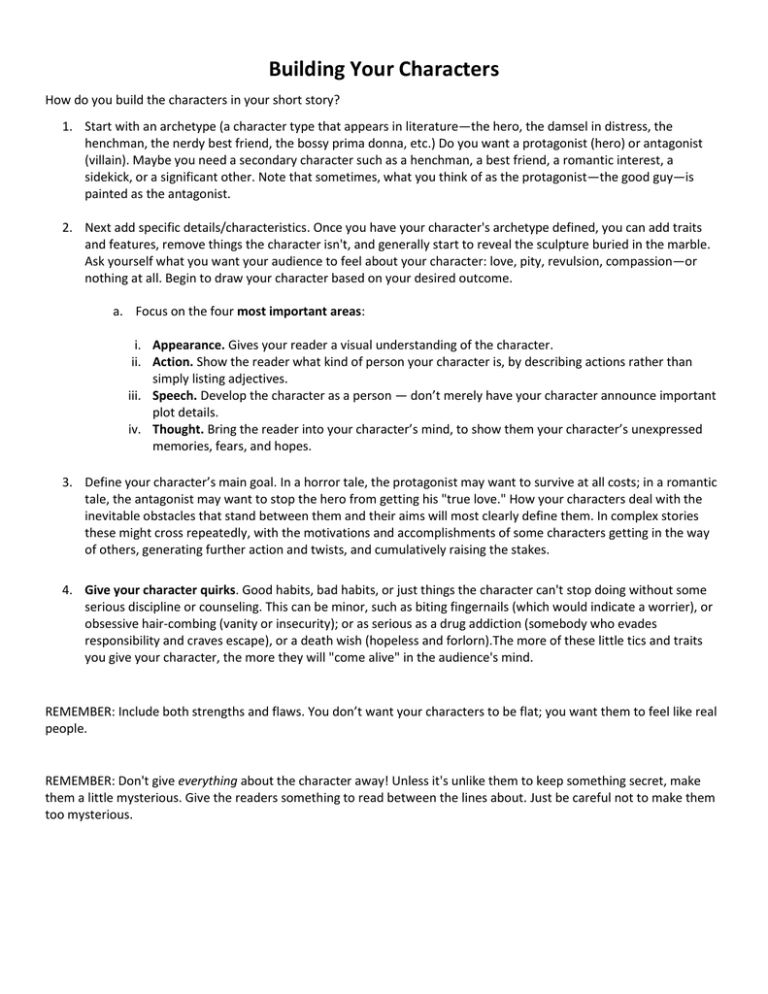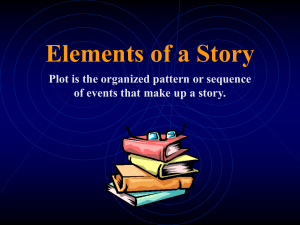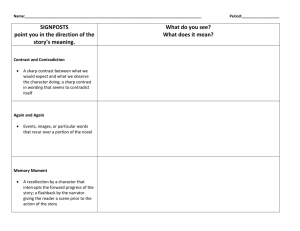Building Your Characters
advertisement

Building Your Characters How do you build the characters in your short story? 1. Start with an archetype (a character type that appears in literature—the hero, the damsel in distress, the henchman, the nerdy best friend, the bossy prima donna, etc.) Do you want a protagonist (hero) or antagonist (villain). Maybe you need a secondary character such as a henchman, a best friend, a romantic interest, a sidekick, or a significant other. Note that sometimes, what you think of as the protagonist—the good guy—is painted as the antagonist. 2. Next add specific details/characteristics. Once you have your character's archetype defined, you can add traits and features, remove things the character isn't, and generally start to reveal the sculpture buried in the marble. Ask yourself what you want your audience to feel about your character: love, pity, revulsion, compassion—or nothing at all. Begin to draw your character based on your desired outcome. a. Focus on the four most important areas: i. Appearance. Gives your reader a visual understanding of the character. ii. Action. Show the reader what kind of person your character is, by describing actions rather than simply listing adjectives. iii. Speech. Develop the character as a person — don’t merely have your character announce important plot details. iv. Thought. Bring the reader into your character’s mind, to show them your character’s unexpressed memories, fears, and hopes. 3. Define your character’s main goal. In a horror tale, the protagonist may want to survive at all costs; in a romantic tale, the antagonist may want to stop the hero from getting his "true love." How your characters deal with the inevitable obstacles that stand between them and their aims will most clearly define them. In complex stories these might cross repeatedly, with the motivations and accomplishments of some characters getting in the way of others, generating further action and twists, and cumulatively raising the stakes. 4. Give your character quirks. Good habits, bad habits, or just things the character can't stop doing without some serious discipline or counseling. This can be minor, such as biting fingernails (which would indicate a worrier), or obsessive hair-combing (vanity or insecurity); or as serious as a drug addiction (somebody who evades responsibility and craves escape), or a death wish (hopeless and forlorn).The more of these little tics and traits you give your character, the more they will "come alive" in the audience's mind. REMEMBER: Include both strengths and flaws. You don’t want your characters to be flat; you want them to feel like real people. REMEMBER: Don't give everything about the character away! Unless it's unlike them to keep something secret, make them a little mysterious. Give the readers something to read between the lines about. Just be careful not to make them too mysterious. Building Your Characters Using Dialogue Another way to build your characters is through what they say, how they say it, and how they respond to what others say. Dialogue is what your characters say to each other (or to themselves). Each speaker gets his/her own paragraph, and the paragraph includes whatever you wish to say about what the character is doing when speaking. “Where are you going?” John cracked his knuckles while he looked at the floor. “To the racetrack.” Mary edged toward the door, keeping her eyes on John’s bent head. “Not again,” John stood up, flexing his fingers. “We are already maxed out on our credit cards.” The above paragraph is confusing, because it is not clear when one speech stops and the other starts. “Where are you going?” John asked nervously. “To the racetrack,” Mary said, trying to figure out whether John was too upset to let her get away with it this time. “Not again,” said John, wondering how they would make that month’s rent. “We are already maxed out on our credit cards.” The second example is mechanically correct, since it uses a separate paragraph to present each speaker’s turn advancing the conversation. But the narrative material between the direct quotes is mostly useless. QUICK GRAMMAR RULES FOR DIALOGUE: In general, put your punctuation INSIDE the quotation marks. Set off your tags with a comma (unless using an exclamation point or a question mark). Begin a new paragraph every time you change speakers. Write Meaningful Dialogue Labels “John asked nervously” is an example of “telling.” The author could write “John asked very nervously” or “John asked so nervously that his voice was shaking,” and it still wouldn’t make the story any more effective. How can the author convey John’s state of mind, without coming right out and tellinig the reader about it? By inference. That is, mention a detail that conjures up in the reader’s mind the image of a nervous person. John sat up. “Wh– where are you going?” “Where are you going?” John stammered, staring at his Keds. Deep breath. Now or never. “Where are you going?” John sat up and took a deep breath, knowing that his confrontation with Mary had to come now, or it would never come at all. “Wh– where are you going?” he stammered nervously, staring at his Keds. Beware — a little detail goes a long way. Why would your reader bother to think about what is going on, if the author carefully explains what each and every line means? Let’s return to the first example, and show how dialogue labels and paragraphing can affect the meaning of a passage. “Where are you going?” John cracked his knuckles while he looked at the floor. “To the racetrack.” Mary edged toward the door, keeping her eyes on John’s bent head. “Not again,” John stood up, flexing his fingers. “We are already maxed out on our credit cards.” In the above revision, John nervously asks Mary where she is going, and Mary seems equally nervous about going. But if you play a little with the paragraphing.. “Where are you going?” John cracked his knuckles while he looked at the floor. “To the racetrack.” Mary edged toward the door, keeping her eyes on John’s bent head. “Not again.” John stood up, flexing his fingers. “We are already maxed out on our credit cards.” All I changed was the paragraphing (and I changed a comma to a period.)Now Mary seems more aggressive — she seems to be moving to block John, who seems nervous and self-absorbed. And John seems to be bringing up the credit card problem as an excuse for his trip to the racing track. He and Mary seem to be desperate to for money now. I’d rather read the rest of the second story than the rest of the first one. CREATE A CONVERSATION BETWEEN TWO ELDERLY MEN WHO PLAY CHESS EVERY TUESDAY IN THE PARK. Point of View Point of view is the narration of the story from the perspective of first, second, or third person. As a writer, you need to determine who is going to tell the story and how much information is available for the narrator to reveal in the short story. The narrator can be directly involved in the action subjectively, or the narrator might only report the action objectively. First Person. The story is told from the view of “I.” The narrator is either the protagonist (main character) and directly affected by unfolding events, or the narrator is a secondary character telling the story revolving around the protagonist. This is a good choice for beginning writers because it is the easiest to write. I saw a tear roll down his cheek. I had never seen my father cry before. I looked away while he brushed the offending cheek with his hand. Second Person. The story is told directly to “you”, with the reader as a participant in the action. You laughed loudly at the antics of the clown. You clapped your hands with joy. Third Person. The story tells what “he”, “she,” or “it” does. The third-person narrator’s perspective can be limited (telling the story from one character’s viewpoint) or omniscient (where the narrator knows everything about all of the characters). He ran to the big yellow loader sitting on the other side of the gravel pit shack. WRITE ABOUT THE LAST DAY OF A PRISONER ON DEATH ROW. WRITE TWO DIFFERENT OPENINGS TO THIS STORY, EACH FROM A DIFFERENT PERSPECTIVE.






